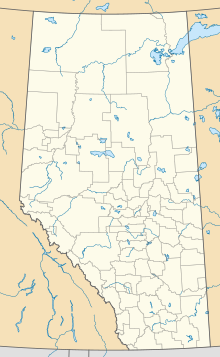Bruce, Alberta
Bruce | |
|---|---|
 Bruce Hotel and Restaurant | |
Location of Bruce in Alberta | |
| Coordinates: 53°10′24″N 112°2′20″W / 53.17333°N 112.03889°W | |
| Country | Canada |
| Province | Alberta |
| Census division | No. 10 |
| Municipal district | Beaver County |
| Government | |
| • Type | Unincorporated |
| • Governing body | Beaver County Council |
| Area (2021)[1] | |
| • Land | 0.86 km2 (0.33 sq mi) |
| Elevation | 680 m (2,230 ft) |
| Population (2021)[1] | |
• Total | 65 |
| • Density | 75.7/km2 (196/sq mi) |
| Time zone | UTC-7 (MST) |
| • Summer (DST) | UTC-6 (MDT) |
| Postal Code | |
Bruce is a hamlet in Alberta, Canada within Beaver County.[2] It is located along Highway 14 between Viking and Ryley, approximately 115 kilometers (71 mi) east of Edmonton, and has an elevation of 680 meters (2,230 ft).
The community has the middle name of A. Bruce Smith, a telephone executive.[3]
The hamlet is located in Census Division No. 10 and in the federal riding of Vegreville-Wainwright.
The Bruce Hotel is known to have the best steak in Alberta, and only operates on Friday and Saturday evenings.
Demographics
In the 2021 Census of Population conducted by Statistics Canada, Bruce had a population of 65 living in 40 of its 53 total private dwellings, a change of 8.3% from its 2016 population of 60. With a land area of 0.86 km2 (0.33 sq mi), it had a population density of 75.6/km2 (195.8/sq mi) in 2021.[1]
As a designated place in the 2016 Census of Population conducted by Statistics Canada, Bruce had a population of 50 living in 31 of its 51 total private dwellings, a change of -16.7% from its 2011 population of 60. With a land area of 0.86 km2 (0.33 sq mi), it had a population density of 58.1/km2 (150.6/sq mi) in 2016.[4]
Notable residents
See also
References
- ^ Jump up to: a b c "Population and dwelling counts: Canada and designated places". Statistics Canada. February 9, 2022. Retrieved February 10, 2022.
- ^ "Specialized and Rural Municipalities and Their Communities" (PDF). Alberta Municipal Affairs. June 3, 2024. Retrieved June 14, 2024.
- ^ Place-names of Alberta. Ottawa: Geographic Board of Canada. 1928. p. 25.
- ^ "Population and dwelling counts, for Canada, provinces and territories, and designated places, 2016 and 2011 censuses – 100% data (Alberta)". Statistics Canada. February 8, 2017. Retrieved February 13, 2017.
External links




